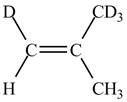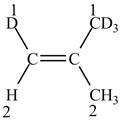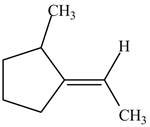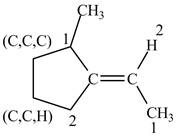
Concept explainers
(a)
Interpretation:
The
Concept introduction:
Answer to Problem 4.47AP
The configuration assigned to the given structure is
Explanation of Solution
The

Figure 1
In this case, bromide ion gets priority over chloride ion and iodide ion gets priority over chloride ion. The structure with higher priority order is written as shown below.

Figure 2
The higher priority groups are present on opposite sides of the double bond. As a result,
The configuration of the given structure is
(b)
Interpretation:
The
Concept introduction:
Alkenes are the unsaturated class of organic compounds which have a double bond in their structure. The general formula of alkene is written as
Answer to Problem 4.47AP
The configuration assigned to the given structure is
Explanation of Solution
The

Figure 3
In this case, the

Figure 4
The higher priority atoms are present on the same side of the double bond. As a result,
The configuration of the given structure is
(c)
Interpretation:
The
Concept introduction:
Alkenes are the unsaturated class of organic compounds which have a double bond in their structure. The general formula of alkene is written as
Answer to Problem 4.47AP
The configuration assigned to the given structure is
Explanation of Solution
The

Figure 5
In this case, right side of double bond contains

Figure 6
One carbon atom is attached to three carbon atoms and other attached to two carbon atoms. Therefore, the carbon atom which is attached to three carbon atoms gets higher priority. As a result, higher priority atoms are present on opposite sides of the double bond. The structure is assigned
The configuration of the given structure is
(d)
Interpretation:
The
Concept introduction:
Alkenes are the unsaturated class of organic compounds which have a double bond in their structure. The general formula of alkene is written as
Answer to Problem 4.47AP
The configuration assigned to the given structure is
Explanation of Solution
The

Figure 7
In this case, left and right side of the double bond contains a carbon atoms cyclic ring whose priority order is identified on the basis of higher priority order atoms attached to its carbon atom which is marked as shown below.

Figure 8
On both sides, One carbon atom is attached to three carbon atoms and other attached to two carbon atoms. Therefore, the carbon atom which is attached to three carbon atoms gets higher priority. Along with double bond get higher priority over the single bond. As a result, higher priority atoms are present on opposite sides of the double bond. The structure is assigned
The configuration of the given structure is
Want to see more full solutions like this?
Chapter 4 Solutions
Organic Chemistry Study Guide and Solutions
- Calculate the pH and the pOH of each of the following solutions at 25 °C for which the substances ionize completely: (a) 0.000259 M HClO4arrow_forwardWhat is the pH of a 1.0 L buffer made with 0.300 mol of HF (Ka = 6.8 × 10⁻⁴) and 0.200 mol of NaF to which 0.160 mol of NaOH were added?arrow_forwardDetermine if the following salt is neutral, acidic or basic. If acidic or basic, write the appropriate equilibrium equation for the acid or base that exists when the salt is dissolved in aqueous solution. If neutral, simply write only NR. Be sure to include the proper phases for all species within the reaction. NaN₃arrow_forward
- A. Draw the structure of each of the following alcohols. Then draw and name the product you would expect to produce by the oxidation of each. a. 4-Methyl-2-heptanol b. 3,4-Dimethyl-1-pentanol c. 4-Ethyl-2-heptanol d. 5,7-Dichloro-3-heptanolarrow_forwardWhat is the pH of a 1.0 L buffer made with 0.300 mol of HF (Ka = 6.8 × 10⁻⁴) and 0.200 mol of NaF to which 0.160 mol of NaOH were added?arrow_forwardCan I please get help with this.arrow_forward
- Determine if the following salt is neutral, acidic or basic. If acidic or basic, write the appropriate equilibrium equation for the acid or base that exists when the salt is dissolved in aqueous solution. If neutral, simply write only NR. Be sure to include the proper phases for all species within the reaction. N₂H₅ClO₄arrow_forwardPlease help me with identifying these.arrow_forwardCan I please get help with this?arrow_forward
 ChemistryChemistryISBN:9781305957404Author:Steven S. Zumdahl, Susan A. Zumdahl, Donald J. DeCostePublisher:Cengage Learning
ChemistryChemistryISBN:9781305957404Author:Steven S. Zumdahl, Susan A. Zumdahl, Donald J. DeCostePublisher:Cengage Learning ChemistryChemistryISBN:9781259911156Author:Raymond Chang Dr., Jason Overby ProfessorPublisher:McGraw-Hill Education
ChemistryChemistryISBN:9781259911156Author:Raymond Chang Dr., Jason Overby ProfessorPublisher:McGraw-Hill Education Principles of Instrumental AnalysisChemistryISBN:9781305577213Author:Douglas A. Skoog, F. James Holler, Stanley R. CrouchPublisher:Cengage Learning
Principles of Instrumental AnalysisChemistryISBN:9781305577213Author:Douglas A. Skoog, F. James Holler, Stanley R. CrouchPublisher:Cengage Learning Organic ChemistryChemistryISBN:9780078021558Author:Janice Gorzynski Smith Dr.Publisher:McGraw-Hill Education
Organic ChemistryChemistryISBN:9780078021558Author:Janice Gorzynski Smith Dr.Publisher:McGraw-Hill Education Chemistry: Principles and ReactionsChemistryISBN:9781305079373Author:William L. Masterton, Cecile N. HurleyPublisher:Cengage Learning
Chemistry: Principles and ReactionsChemistryISBN:9781305079373Author:William L. Masterton, Cecile N. HurleyPublisher:Cengage Learning Elementary Principles of Chemical Processes, Bind...ChemistryISBN:9781118431221Author:Richard M. Felder, Ronald W. Rousseau, Lisa G. BullardPublisher:WILEY
Elementary Principles of Chemical Processes, Bind...ChemistryISBN:9781118431221Author:Richard M. Felder, Ronald W. Rousseau, Lisa G. BullardPublisher:WILEY





